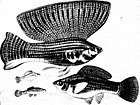Wikipedia:Main Page history/2023 October 7
From today's featured article

Boukephala and Nikaia were two cities founded by Alexander the Great on either side of the Hydaspes river during his invasion of the Indian subcontinent. The cities, two of many founded by Alexander, were built shortly after his victory over the Indian king Porus at the Battle of the Hydaspes in early 326 BC. It is not certain which settlement had which name. Built on the site of the battlefield, the city on the eastern bank was most likely called Nikaia, while its western companion was probably named after Alexander's horse Bucephalus, who died during or after the battle. Their construction was supervised by Craterus, one of Alexander's leading generals. Boukephala seems to have had a more distinguished legacy than Nikaia: it was mentioned by Roman authors and appears on later manuscripts. The cities' precise locations are unknown, but it is considered likely that Boukephala was located in the vicinity of modern Jalalpur, Pakistan, and that Nikaia was across the river near present-day Mong. (Full article...)
Did you know ...
- ... that the swordtail molly (examples pictured) and the Petén molly have been named and renamed so often, one even ending up with the other's name at one point, that the swordtail molly's current scientific name means 'confusion'?
- ... that physics, chemistry, and biology were all part of philosophy before they became separate disciplines?
- ... that artist Percy Delf Smith's work included lettering using Roman capitals and depictions of the First World War inspired by his experiences in the trenches?
- ... that the perpetrator of the 2006 San Miguel shooting greeted some former co-workers and shot at others?
- ... that a dispute over paid sick leave at a chocolate factory ended up before the High Court of Australia in Mondelez v AMWU?
- ... that the Park Avenue Armory was leased out as an art center because the New York state government could not pay for repairs?
- ... that during her 2023 season, Aryna Sabalenka became the first woman since Serena Williams in 2016 to reach the semifinals at all four majors in a season?
- ... that Death Valley Girls have been described as "doom-boogie psych-pop"?
In the news
- Twenty-one people are killed when a bus falls from a bridge (aftermath pictured) near Venice, Italy.
- In the United States, Kevin McCarthy is removed as Speaker of the House.
- Katalin Karikó and Drew Weissman are awarded the Nobel Prize in Medicine for discoveries that led to the mRNA vaccines against COVID-19.
- In Australian rules football, Collingwood defeat the Brisbane Lions to win the AFL Grand Final.
On this day
- 1571 – Ottoman–Habsburg wars: The Battle of Lepanto was fought near the Gulf of Corinth, a significant setback for the Ottoman Empire and the last major naval battle fought entirely with galleys.
- 1878 – The state funeral of Mindon Min (pictured), who ruled Myanmar for 25 years, took place; his death was reportedly preceded by strange omens, and his senior princes were unable to attend as they had all been arrested.
- 1916 – Georgia Tech defeated Cumberland University 222–0 in the most lopsided college football game in American history.
- 1991 – Croatian War of Independence: The Yugoslav People's Army conducted an air strike on Banski Dvori, the official residence of the president of Croatia in Zagreb.
- 2008 – 2008 TC3 exploded above the Nubian Desert in Sudan, in the first time that an asteroid impact had been predicted prior to atmospheric entry.
- Pierre Le Muet (b. 1591)
- Charles XIII (b. 1748)
- Mariano Gagnon (b. 1929)
- Beatrice Hutton (d. 1990)
Today's featured picture

|
Agrius cingulata, commonly known as the pink-spotted hawkmoth or sweetpotato hornworm, is a moth in the family Sphingidae. The species was first described by Johan Christian Fabricius in 1775. It has a wide range throughout the Americas, with adults migrating north to Canada and south to Patagonia and the Falkland Islands. It can also be found in the Galápagos Islands and Hawaii, and has been found in western Europe and West Africa. A nocturnal insect, A. cingulata feeds on the nectar from deep-throated flowers including moonflower, morning glories and petunia. Its larva is a large, stout caterpillar with a horn, which feeds during the day and the night on sweet potato, Datura, and other plants. This male A. cingulata moth was photographed in the Mount Totumas cloud forest in Panama. Photograph credit: Charles J. Sharp
Recently featured:
|
Other areas of Wikipedia
- Community portal – The central hub for editors, with resources, links, tasks, and announcements.
- Village pump – Forum for discussions about Wikipedia itself, including policies and technical issues.
- Site news – Sources of news about Wikipedia and the broader Wikimedia movement.
- Teahouse – Ask basic questions about using or editing Wikipedia.
- Help desk – Ask questions about using or editing Wikipedia.
- Reference desk – Ask research questions about encyclopedic topics.
- Content portals – A unique way to navigate the encyclopedia.
Wikipedia's sister projects
Wikipedia is written by volunteer editors and hosted by the Wikimedia Foundation, a non-profit organization that also hosts a range of other volunteer projects:
-
Commons
Free media repository -
MediaWiki
Wiki software development -
Meta-Wiki
Wikimedia project coordination -
Wikibooks
Free textbooks and manuals -
Wikidata
Free knowledge base -
Wikinews
Free-content news -
Wikiquote
Collection of quotations -
Wikisource
Free-content library -
Wikispecies
Directory of species -
Wikiversity
Free learning tools -
Wikivoyage
Free travel guide -
Wiktionary
Dictionary and thesaurus
Wikipedia languages
This Wikipedia is written in English. Many other Wikipedias are available; some of the largest are listed below.
-
1,000,000+ articles
-
250,000+ articles
-
50,000+ articles



